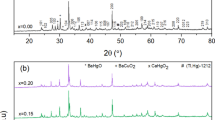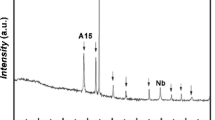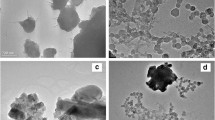Abstract
The superconductor was first discovered in liquid metal Hg. Since then, the researches about superconductors have mainly focused on solid materials, instead of the liquid metal alloys. Recently, the gallium–indium–tin (Ga-In-Sn) liquid alloy was found to exhibit superconducting properties at low temperatures. In this work, the superconducting properties of the Ga-In-Sn liquid alloy (Ga:In:Sn = 62:25:13 by weight) and the Zn-doped samples have been studied. The results indicate that the Ga-In-Sn liquid alloy has the superconducting critical temperature (TC) of 6.28 K. With the addition of Zn, the TC is reduced to 6.06 K. Besides, at temperature higher than TC, a change from superconductivity to normal state appears, and with the addition of Zn element into the alloy, the magnetic susceptibility is improved. Therefore, based on the research of liquid metal’s superconductivity in this work, more physical properties and applied researches on liquid metal can be proposed in future, and more novel applications can be developed.






Similar content being viewed by others
Data availability
All data generated or analyzed during this study are included in this published article [and its supplementary information files].
References
F. Beckers, J. Rinklebe, Cycling of mercury in the environment: sources, fate, and human health implications: A review. Crit. Rev. Environ. Sci. Technol. 47(9), 693 (2017)
E. Snider et al., Room-temperature superconductivity in a carbonaceous sulfur hydride (Vol. 586, p. 373, 2020). Nature 588(7837), E18 (2020)
K.S. Yun et al., A surface-tension driven micropump for low-voltage and low-power operations. J. Microelectromech. Syst. 11(5), 454 (2002)
J. Ni et al., Electrochemically-actuated mercury valve for flow rate and direction control: design, characterization, and applications. J. Electroanal. Chem. 504(2), 166 (2001)
W.J. Shen et al., Electrostatically actuated metal-droplet microswitches integrated on CMOS chip. J. Microelectromech. Syst. 15(4), 879 (2006)
F.D. Manilevich et al., Studies of the hydrolysis of aluminum activated by additions of Ga-In-sn eutectic alloy, bismuth, or antimony. Mater. Sci. 55(4), 536 (2020)
C.W. Chu et al., Epilogue: superconducting materials past, present and future. Physica C 514, 437 (2015)
E.P. Romanov et al., Mechanism of formation, fine structure, and superconducting properties of high-temperature superconductors and superconducting composites. Phys. Met. Metallogr. 101(1), 33 (2006)
D.S. Inosov et al., Normal-state spin dynamics and temperature-dependent spin-resonance energy in optimally doped BaFe1.85Co0.15As2. Nat. Phys. 6(3), 178 (2010)
H.Y. Zhang, Toxic effect of Cd and Hg stress on pea seed. J. Anhui Agric. Sci. 36(31), 13539 (2008)
P. Sen, C.J. Kim, A fast liquid-metal droplet microswitch using EWOD-driven contact-line sliding. J. Microelectromech. Syst. 18(1), 174 (2009)
P. Sen, C.J. Kim, A liquid-solid direct contact low-loss RF micro switch. J. Microelectromech. Syst. 18(5), 990 (2009)
L.R. Bernstein, Mechanisms of therapeutic activity for gallium. Pharmacol. Rev. 50(4), 665 (1998)
K.E. Spells, The determination of the viscosity of liquid gallium over an extended nrange of temperature. Proc. Phys. Soc. 48(2), 299 (1936)
V. Filippov et al., Viscosity of Ga-rich alloys in the Ga-In-Sn system. J. Alloy. Compd. 789, 66 (2019)
N.F. Mott, The resistance of liquid metals. Proc. R. Soc. Lond. 146(857), 465 (1934)
J. Briggs Lyman, Gallium: thermal conductivity; supercooling; negative pressure. J. Chem. Phys. 26(4), 784 (1957)
J. Pinson, Encyclopedia of the Electrochemistry of the Elements—Organic Sections, vol. XIV (Marcel Dekker, New York, 1980), p. 308
E.J. Lous, Formation of a schottky barrier between eutectic Ga, In and thiophene oligomers. J. Appl. Phys. 81(8), 3537 (1997)
A. Du Pasquier et al., On the use of Ga-In eutectic and halogen light source for testing P3HT-PCBM organic solar cells. Sol. Energy Mater. Sol. Cells 90(12), 1828 (2006)
S. Yu, M. Kaviany, Electrical, thermal, and species transport properties of liquid eutectic Ga-In and Ga-In-Sn from first principles. J. Chem. Phys. 140(6), 064303 (2014)
D.S. Evans et al., Thermal analysis of Ga-In-Sn system. Metal Sci. 12(9), 411 (1978)
M.D. Dickey, Emerging applications of liquid metals featuring surface oxides. ACS Appl. Mater. Interfaces 6(21), 18369 (2014)
T. Mochiku et al., Synthesis of InSn alloy superconductor below room temperature. Physica C 563, 33 (2019)
L. Ren et al., Nanodroplets for stretchable superconducting circuits. Adv. Funct. Mater. 26(44), 8111 (2016)
Y. Guo et al., Superconductivity modulated by quantum size effects. Science 5708, 1105130 (2004)
C. Granata, A. Vettoliere, Nano superconducting quantum interference device: a powerful tool for nanoscale investigations. Phys. Rep. 614, 1 (2016)
Y. Zhang et al., Superconductivity modulated by quantum size effects. J. Chin. Electron. Microsc. Soc. 23(6), 599 (2004)
A.J. Downs, Chemistry of Aluminium, Gallium, Indium and Thallium (Springer, New York, 1992)
C. Oh et al., Influence of oxygen partial pressure in In-Sn-Ga-O thin-film transistors at a low temperature. J. Alloy. Compd. 805, 211 (2019)
M.F. Merriam et al., Superconductivity in the indium-tin system. Phys. Rev. 131(2), 637 (1963)
G. Knapp, M.F.J.P.R. Merriam, Superconductivity in the tin-gallium system. Phys. Rev. 140(2A), 528 (1965)
R. Kubiak et al., Crystallization, decomposition and superconductivity of β-In3Sn. J. Less-Common Metals 65(2), 263 (1979)
G. Hernandez et al., Superconductivity of In-Ga (fct). J. Low Temp. Phys. 46(1–2), 71 (1982)
M.K. Rudziak, T. Wong, Development of a Nb3Sn conductor containing Ga and Mg dopants. IEEE Trans. Appl. Supercond. 11(1), 3580 (2001)
V.Y. Verchenko et al., Endohedral cluster superconductors in the Mo-Ga-Sn system explored by the joint flux technique. Inorg. Chem. 58(22), 15552 (2019)
T. Shishido et al., Chemical state and properties of the Nb5Sn2Ga grown by the self-component flux method using tin as a solvent. J. Alloy. Compd. 281(2), 196 (1998)
A. Dobosz et al., Liquid metals in high-temperature cooling systems: the effect of Bi additions for the physicochemical properties of eutectic Ga-Sn-Zn. J. Chem. Eng. Data 64(2), 404 (2019)
J. Lopez-Sanchez et al., Multiphase materials based on the Fe7.39Si1.55Cu1Nb3B6.6 alloy obtained by dry and wet high-energy ball milling processes. J. Alloys Compd. 864, 158136 (2021)
Y. Plevachuk et al., Thermophysical properties of the liquid Ga–In–Sn eutectic alloy. J. Chem. Eng. Data 59(3), 757 (2014)
Acknowledgements
This work was supported by the National Natural Science Foundation of China (51973100), the National Key Research and Development Project of China (2019YFC0121402), and State Key Laboratory of Bio-Fibers and Eco-Textiles, Qingdao University (RZ2000003334).
Author information
Authors and Affiliations
Contributions
All authors contributed to the study conception and design. Material preparation, data collection, and analysis were performed by [T-TZ, G-XX, and G-TC]. The first draft of the manuscript was written by [T-TZ] and all authors commented on previous versions of the manuscript. All authors read and approved the final manuscript.
Corresponding authors
Ethics declarations
Conflict of interest
The authors declare that they have no known competing financial interests or personal relationships that could have appeared to influence the work reported in this paper.
Informed consent
All authors have informed consent.
Research involving human and animal participants
Research doesn’t involve Human Participants or Animals.
Additional information
Publisher's Note
Springer Nature remains neutral with regard to jurisdictional claims in published maps and institutional affiliations.
Supplementary Information
Below is the link to the electronic supplementary material.
Rights and permissions
About this article
Cite this article
Zhang, TT., Xie, GX., Cheng, GT. et al. Superconductivity of Ga-In-Sn liquid alloy. J Mater Sci: Mater Electron 33, 10021–10029 (2022). https://doi.org/10.1007/s10854-022-07993-5
Received:
Accepted:
Published:
Issue Date:
DOI: https://doi.org/10.1007/s10854-022-07993-5




